“Perchance to Dream”
Story by Laren Bright and Michael Reaves
Teleplay by Joe R. Lansdale
Directed by Boyd Kirkland
Episode #030
Music Composed by Shirley Walker
Animation by Dong Yang Animation Co., LTD.
Original Airdate—October 19th, 1992
Plot: Bruce Wayne wakes up in a world where his parents never died, he’s engaged to Selina Kyle, and someone else is Batman.
The Mad Hatter trapping Bruce Wayne in a dream of his perfect world feels like Laren Bright and Michael Reaves’s reinterpreted one of the best Superman stories ever, Alan Moore and Dave Gibbons’s “For the Man Who Has Everything.” But the final fight in the bell tower between Bruce Wayne and Batman for control of Batman’s psyche feels closer to the scene in the junkyard from Superman III. Which once again shows Batman: The Animated Series picks up its influences from everywhere.
In “Dreams in Darkness,” we saw Batman’s greatest fear: that he alone can save Gotham. Therefore, it makes sense that his greatest desire is that anyone else were Batman. We get to see Bruce’s perspective on Batman as an outside observer. He is impressed by Batman’s bravery and athleticism, admires his accomplishments, and understands Gotham’s need for a protector. But beyond his parents being alive, beyond Selina not being a criminal, in Bruce Wayne’s dream world Batman is not Bruce. Because apparently Bruce Wayne hates being Batman.
“All the years of training and discipline” are a nightmare he is glad to wake up from, and given the choice, he’d prefer to be a playboy millionaire who’s marrying a debutante but maybe has a thing on the side with a young lady named Robin. He’d prefer to be CEO of a company someone else actually runs. He’d prefer Alfred not have to be a dryly witty father and mother to him, and could just be a butler. He’d prefer a life of ease and comfort, where he didn’t have to work for anything and everyone was happy.
Kevin Conroy gives one of his best performances here. Besides doing triple duty as Bruce, Thomas Wayne, and Evil Batman, Conroy gives such joy and life to the brief scenes where Bruce thinks that maybe, just maybe, he doesn’t have to be a caped crusader, that Bruce sounds ten years younger. Alfred is right, it is good to see Bruce in good humor, but his joy also makes the moment the illusion of his perfect life shatters that much more heartbreaking.

(Personal note, even though the “can’t read in dreams” argument relies on some outdated ideas of how the hemispheres of the brain work, since seeing this episode, I’ve been trying to read in my dreams and, nope, can’t do it.)
Boyd Kirkland’s direction and Shirley Walker’s score do a great job of making Batman’s real world of car chases and costumed villains seem mundane compared to his dad talking about golfing, which is queasily off-putting. We share Bruce’s sense that “something is wrong.” And as much as Bruce does not want to be Batman, he cannot stop being Batman, even in his dreams. Thus, even when Bruce appears to go crazy, climbing bell towers to yell at the sky, he is in fact being logical, following his own patrol patterns to ambush NotBatman.

And every clue (including a nonsense sign before and after the newspaper reveal), every incongruity, and every person in the dream, including and especially Evil Batman/Dream Mad Hatter, is really a manifestation of Bruce’s own mind showing him the way back. After all, the real Mad Hatter couldn’t be communicating with Bruce, so subconsciously, Batman must have narrowed the suspects down to the two rogues who can manipulate minds, realized he wasn’t terrified, and known it wasn’t Scarecrow under the mask. So when the Dream Mad Hatter explains the plot to Bruce, it’s actually Bruce’s subconscious explaining the plot to his waking brain.
That Bruce realizes he’s dreaming halfway into the episode saves the “it was all a dream” story trope, because knowing he’s dreaming doesn’t resolve the plot. He still can’t wake up and Bruce’s subconscious using the Mad Hatter’s voice says he could spend the rest of his life trapped in a dream in Arkham (how do you like them apples, Inception?). And Bruce doesn’t know that committing suicide within the dream will work, he just knows he can’t live his life within a lie. Also, thanks Joe R. Landsdale, because “I’ll see you in your nightmares” are pretty badass last words.
Again, we’re seeing a villain, like the Scarecrow and the Clock King, setting a trap specifically to catch Batman, as the bad guys start chasing Batman rather than being chased. The Mad Hatter, the real one, claims Batman ruined his life, though it’s hard to see in “Mad as a Hatter” how anyone other than Jervis Tetch himself is to blame. But it’s easier for him to blame Batman than to face his own responsibility. Batman cannot live in a dream world. His villains cannot live in the real one.
“The Cape and Cowl Conspiracy”
Written by Elliot S. Maggin
Directed by Frank Paur
Episode #031
Music Composed by Beth Ertz, Mark Kovel
Animation by Dong Yang Animation Co., LTD.
Original Airdate—October 14th 1992
Plot: Batman hunts Josiah Wormwood, a master of death traps, even as Baron Jozek hires Wormwood to bring him Batman’s cape and cowl.
This is another episode that directly adapts an issue of the comics, this time by the original writer, Elliot S! Maggin. It’s also the first episode that really suffers from re-watching. Batman dealing with a series of death traps, including one that defeats him, only to reveal that he’s been weaving a trap of his own the whole time, is pretty great the first time you see it. But on second viewing, the Fridge Logic kicks in and we realize Batman’s plan is in fact terrible.
First of all, it’s needlessly circuitous. Why the whole rigamarole of disguising himself as the Baron and hiring Wormwood to hunt himself? Why doesn’t Batman just dangle Wormwood off a billboard, like he usually does? A taped confession by use of elaborate disguise is no more admissible as evidence than one coerced through torture, as Batman is not going to testify in court. Why does he even need Wormwood to confess at all, as Wormwood apparently signs his riddles?

Also, the whole plan hinges on Wormwood being so obsessed with why the Baron wants Batman’s mask that he’ll divulge (in needless detail) what he did with the bearer bonds. If Wormwood had been even a little more professional then the whole plan falls apart. And then there’s weird moments like Batman being in costume as the Baron even when he’s just on the phone with Wormwood. I guess he’s just really into method acting.
I’m also not sure why they didn’t go ahead and make this the first Riddler episode. Maggin already adapts this story for The Animated Series continuity by stating the Bat-Signal is new. Why couldn’t Maggin have changed his original villain to one the series needs to introduce anyway. Certainly his rhyming riddles written in ransom note cut out letters, his elaborate death traps, his abuse of P.A. systems, and his obsessive need for answers make Wormwood look like an out of costume Edward Nigma with a blond dye job. And Bud Cort gives a very Riddler-esque performance, full of gloating, patient arrogance and a cloying creepiness that John Glover will replace with that patented John Glover smarm. Cort will put that creepiness, with all its childlike entitlement and need, to better use as the Toyman in Superman: the Animated Series.

Though as long as you don’t question why Batman is employing such an elaborate ruse, it’s an enjoyable episode. John Rhys-Davies also gives a great guest performance as the arrogant Baron and as Batman pretending to be the Baron. Frank Paur’s direction is exciting and tense, especially the dramatic reveal of Batman without his cowl, and the ninja turtle bandana he is wearing underneath. And there’s even a couple of great jokes, the Baron announcing he’s unaccustomed to being sought after just before Batman pounces on him, Wormwood’s scared stiff expression as, defeated, he hands over the key. And it may take an entire episode to set up, but the line “I intend…to wear them,” is a great fuck yeah moment. Not worth putting his life in jeopardy for 22 minutes, but a great line nonetheless.
Steven Padnick is a freelance writer and editor. By day. You can find more of his writing and funny pictures at padnick.tumblr.com.











